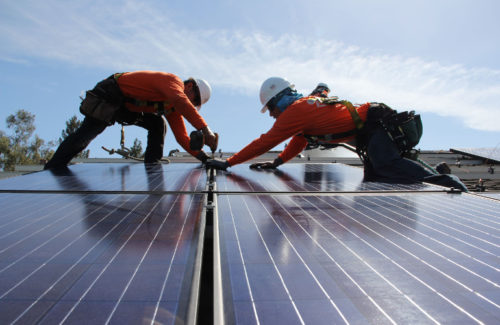The Coalition for Environmental Equity and Economics (CEEE) announced it will be partnering with the Save California Solar campaign to call on Governor Newsom, the California Public Utilities Commission and state leaders to keep solar affordable in California as the Newsom Administration considers changes to net metering.
CEEE is a project of Green the Church, the Environmental Justice Coalition for Water and the Council of Mexican Federations in North America.
“We are happy to be working with rooftop solar advocates to protect and strengthen net metering, advocate for additional policies that will help bring rooftop solar and battery storage to communities of color, and educate solar buyers on their consumer rights,” said CEEE co-founder Rev. Dr. Ambrose Carroll, Sr.
Proposals submitted by the big utilities to gut net metering would drastically reduce the credit solar consumers receive for the excess energy they produce and add a $65-90 monthly solar penalty fee to their energy bills.
“The benefits of rooftop solar are many for the communities we serve. Installing solar panels helps lower the monthly electric bills of families, the industry creates good-paying jobs, and, most importantly, the more rooftop solar, the lower the rate of dirty emissions generally and specifically in our communities,” said COFEM executive director Francisco Moreno.
CEEE is asking California leaders to keep growing and improving rooftop solar to fight climate change and build a more resilient grid. Since many of the state’s low-income solar programs rely directly on net metering to deliver bill savings to vulnerable populations, the alliance emphasizes the need to prioritize equity and continue bringing solar to more people. When coupled with storage, rooftop solar is a consumer’s best defense against spiking energy costs and unpredictable power outages, particularly as wildfire season looms large.
“Communities of color are those most impacted by climate change. They are the communities that live with the health consequences of environmental hazards, and they lack the resources to quickly bounce back from natural disasters. CEEE has a high sense of urgency to ensure California public policy makes the communities we care about a priority,” said Rev. Carroll.
News item from Save California Solar






It seems no one has considered what rates would be if for profit utilities made the capital investments to supply the energy generated by rooftop solar (including the energy it pushes into the grid).
Net energy metering does not allow rooftop solar users to draw from the state power grid for free although it may allow for faster cost recovery. That is not the same as free. Breakeven for rooftop solar (especially with battery) is measured in multiple of years before anything is ‘free.’ It is hard to see a cost advantage (i.e., lesser cost) as free. For most homes, going completely grid-neutral, if possible, will have a breakeven time period measured in decades—but even so, this is not ‘free.’
The for profit utilities merely seek to increase their profits using the capital investment made by others.
My town’s municipal electric utility was faced with possible distribution upgrades required by increasing air conditioning loads from new and larger homes. Their response was to create a town-wide solar panel group purchasing opportunity including financing options. The savings from not needing a distribution upgrade allowed the utility to PAY $1-2,000 of the cost of purchased arrays!
Solarman states the basic issue well. Also remember we care about all communities, and Our communities include, but are not defined by, communities of color.
“Proposals submitted by the big utilities to gut net metering would drastically reduce the credit solar consumers receive for the excess energy they produce and add a $65-90 monthly solar penalty fee to their energy bills.”
This is the battle royal going on right now across the U.S.. IF wholesale energy prices are 2 cents to 6 cents per kWh, is distributed solar PV generation and energy storage that could be used to create a VPP or used as aggregate energy storage or grid services worth more than the wholesale rate for the energy credit? I’d say yes and I’d also say it is only right for someone who payed it forward and has their own system installed, should be compensated for the “avoided costs” the utility enjoys with this and many other distributed generation systems online. The copper wires from your home’s circuit breaker panel to the utility step down transformer has already been paid for when the service was installed or the property developed. Over decades, I recall NO service wires from a utility transformer to the house being replaced once in service. NOW IF something happens to that service to your house, then I can see pulling in a new power cable to the house and perhaps at THAT time the home owner should be paying $65 to $90 a month fee until the parts and labor cost of the replacement is paid off.
At least for now, the utility that services my property allows I believe 7 cents to 9 cents per kWh of excess energy pushed back onto the grid during the day as my energy credit and at night, cloudy days, I buy the power from the utility at 12 cents to 16 cents per kWh.